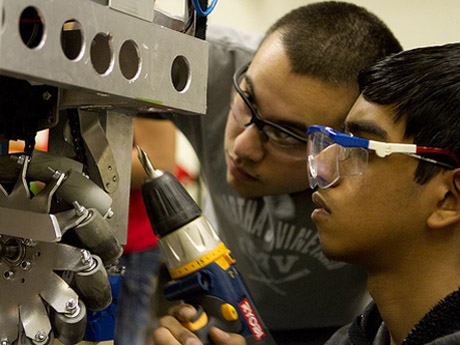Teachers tinker: Education department’s annual Benson Lecture, hands-on workshop bring spirit of maker movement to PLU

Image: The seventh annual Benson Lecture on April 12 will focus on the maker movement and its impact on education. The lecture will be held at 7 p.m. in the Regency Room in the UC.
By Kari Plog '11
PLU Marketing & Communications
TACOMA, WASH. (March 23, 2016)- Imagine using bananas and a circuit board to create a piano. Absurd? Thanks to the maker movement and some creative minds, it isn’t. Pacific Lutheran University’s School of Education & Kinesiology is bringing that creative spirit to campus April 12 in the form of a hands-on workshop and free public lecture.
The seventh annual Benson Lecture, “A Learning Revolution Goes to School: The Maker Movement,” will focus on the growing trend in which creators use so-called “makerspaces” and “fablabs” to invent and create products. More specifically, speakers will discuss how the maker movement has impacted education and how schools can set up their own makerspaces for students.
Makerspaces offer community centers equipped with 3-D printers, laser cutters and other high- and low-tech tools available to people from all walks of life.
“It’s like 21st century wood shop,” said Dr. Leon Reisberg, recipient of the Jolita Hyllan Benson Endowed Chair in Elementary Education.
The workshop and subsequent lecture will feature speakers Sylvia Martinez and Gary Stager, co-authors of the book “Invent to Learn: Making, Tinkering, and Engineering in the Classroom.” Their lecture will touch on how to effectively set up makerspaces in schools to incorporate the maker movement into basic education.
But first, they’ll give teachers and PLU students studying to become teachers the opportunity to test out the technologies that makerspaces offer. Attendees will participate in hands-on learning that will demonstrate how useful the creative spaces can be in schools.
Students use the spaces to exercise their problem-solving muscles in fun and creative ways, such as turning fruit into musical instruments with a so-called “makey makey,” an invention kit, or becoming familiar with Lego robotics.
“I want to get them fired up about this,” Reisberg said of teachers in training. “It really intersects with project-based learning.”
Students learn basic skills in this comprehensive process, he said; problem-solving, creativity, following directions are all at the core of makerspace activities.
“I hope my students walk away excited about how this can help their students be engaged and excited in school,” he said. “It takes learning away from being able to pass standardized tests to being able to use skills in a practical way.”
School-based makerspaces also level the playing field for use of technology by students, he said, making expensive equipment more accessible. Some Tacoma schools are already partnering with FabLab, a local makerspace in downtown Tacoma, to expose local K-12 students to the movement. Programs through Baker Middle School and Fern Hill Elementary allow students to work in the local business on weekends.
“You can start small,” Reisberg said. “But they sky’s the limit.”
Reisberg said the maker movement isn’t just about getting students excited — it’s about igniting passion for teachers, too.
“Teachers really see the light in kids’ eyes,” he said. “They’re the ones who are going to light the fire.”
Conn McQuinn is the director of educational technology for Puget Sound Educational Service District, which partnered with PLU’s School of Education to host the Benson Lecture workshop. McQuinn said school-based makerspaces, prompted by teachers who are exposed to the movement, will encourage kids at a young age to work toward careers in STEM — science, technology, engineering and mathematics.
“Much of the modern economy is being driven by people who are inventing and creating their own products,” McQuinn said. “The idea of bringing the fablab type of experience into schools makes an awful lot of sense.”
He stressed that makerspaces don’t always have to focus on high-tech projects and activities. Everyday items can be used to create innovative products. The “makey makey,” for example, allows kids to hook a circuit board up to objects such as fruit or Play-Doh to make music or play computer games with makeshift controls.
“Tinkering is terribly important,” McQuinn said. “All learning is built on prior understanding. That’s a 21st century skill.”
Even more important, McQuinn added, is preparing students for the ever-changing world of technology.
“We have no idea what tools they’re going to be using when they graduate from college. They haven’t been invented yet,” he said. “(Students) have to have those self-teaching skills. That’s a big part of why the maker movement exists.”
More simply, Reisberg and McQuinn agree that making learning fun is the core of the maker movement.
“If we can help kids understand that it is fun, it is empowering,” McQuinn said, “that’s going to be the greatest benefit.”
A “makey makey” is one example of how the maker movement is empowering people to invent and create:



